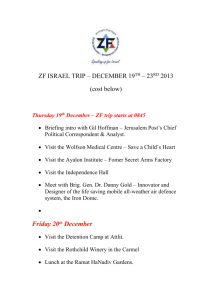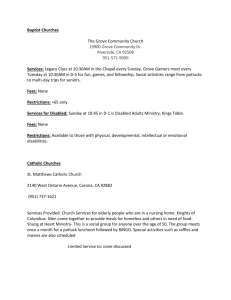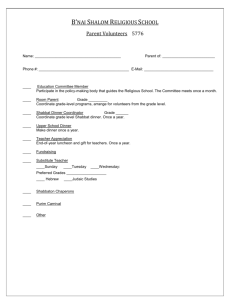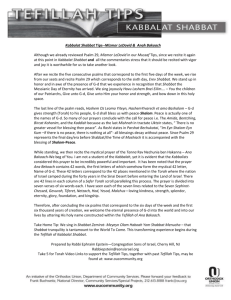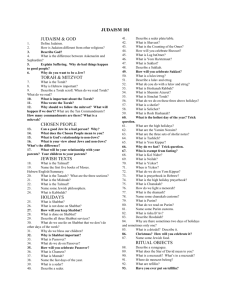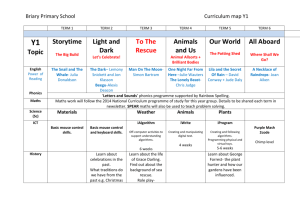Reconstructionism To..
advertisement
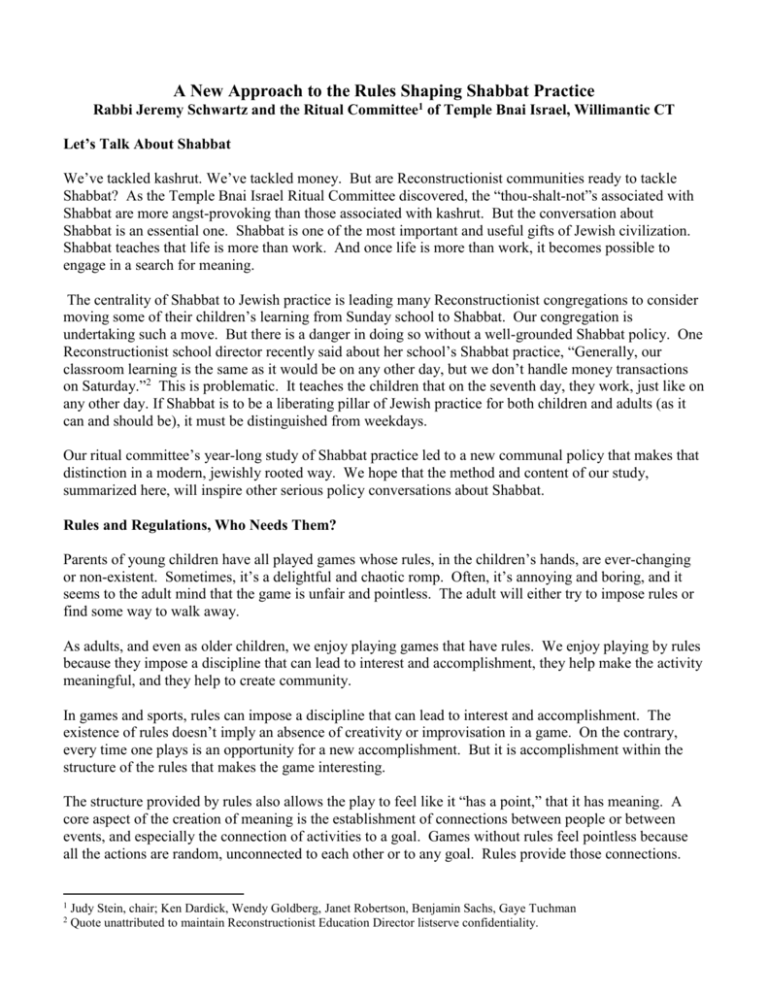
A New Approach to the Rules Shaping Shabbat Practice Rabbi Jeremy Schwartz and the Ritual Committee1 of Temple Bnai Israel, Willimantic CT Let’s Talk About Shabbat We’ve tackled kashrut. We’ve tackled money. But are Reconstructionist communities ready to tackle Shabbat? As the Temple Bnai Israel Ritual Committee discovered, the “thou-shalt-not”s associated with Shabbat are more angst-provoking than those associated with kashrut. But the conversation about Shabbat is an essential one. Shabbat is one of the most important and useful gifts of Jewish civilization. Shabbat teaches that life is more than work. And once life is more than work, it becomes possible to engage in a search for meaning. The centrality of Shabbat to Jewish practice is leading many Reconstructionist congregations to consider moving some of their children’s learning from Sunday school to Shabbat. Our congregation is undertaking such a move. But there is a danger in doing so without a well-grounded Shabbat policy. One Reconstructionist school director recently said about her school’s Shabbat practice, “Generally, our classroom learning is the same as it would be on any other day, but we don’t handle money transactions on Saturday.”2 This is problematic. It teaches the children that on the seventh day, they work, just like on any other day. If Shabbat is to be a liberating pillar of Jewish practice for both children and adults (as it can and should be), it must be distinguished from weekdays. Our ritual committee’s year-long study of Shabbat practice led to a new communal policy that makes that distinction in a modern, jewishly rooted way. We hope that the method and content of our study, summarized here, will inspire other serious policy conversations about Shabbat. Rules and Regulations, Who Needs Them? Parents of young children have all played games whose rules, in the children’s hands, are ever-changing or non-existent. Sometimes, it’s a delightful and chaotic romp. Often, it’s annoying and boring, and it seems to the adult mind that the game is unfair and pointless. The adult will either try to impose rules or find some way to walk away. As adults, and even as older children, we enjoy playing games that have rules. We enjoy playing by rules because they impose a discipline that can lead to interest and accomplishment, they help make the activity meaningful, and they help to create community. In games and sports, rules can impose a discipline that can lead to interest and accomplishment. The existence of rules doesn’t imply an absence of creativity or improvisation in a game. On the contrary, every time one plays is an opportunity for a new accomplishment. But it is accomplishment within the structure of the rules that makes the game interesting. The structure provided by rules also allows the play to feel like it “has a point,” that it has meaning. A core aspect of the creation of meaning is the establishment of connections between people or between events, and especially the connection of activities to a goal. Games without rules feel pointless because all the actions are random, unconnected to each other or to any goal. Rules provide those connections. 1 2 Judy Stein, chair; Ken Dardick, Wendy Goldberg, Janet Robertson, Benjamin Sachs, Gaye Tuchman Quote unattributed to maintain Reconstructionist Education Director listserve confidentiality. Finally, rules help to create community because they allow people to know what to do with each other. They provide a structure of interaction. That, indeed, is a major purpose of all our Temple’s congregational policies, including our Shabbat policy. Our policies allow the formation of community. Rules play similar roles in music, language, and literature to those they play in sports: they allow creativity within a structure that promotes discipline and challenge, leading to interest, accomplishment, meaning, and community. The same may be said about Judaism. A set of agreed-upon rules of practice within a Jewish community can promote discipline and challenge, leading to interest, accomplishment, meaning, and community. In addition to these generic functions of rules, the rules of Shabbat practice, both the positive (“thou shalt”) and the negative (“thou shalt not”), provide benefits specific to Shabbat. Our committee asked ourselves: “Are there things that you would like to be sure to do at least one day a week?” We could all think of such things: be grateful for what I have, mindful of what I do, pay attention to now, walk, read Jewish literature… We also wondered, “Would you like to be sure to have a day without certain things every week?” Some answers included cleaning, ordering, worrying, shopping. One person asked, “How do I learn to stop?” Shabbat can be a dike against the sometimes chaotic and insistent pressures of life. But Which Rules? Giving Tradition a Vote, But Not a Veto Given the above, we want rules that will facilitate the existence of a community practicing Shabbat together and that will give shape and structure to our search for holiness, blessing and meaning. But which rules? There is no single set of rules that we share in our personal practice or to which we all attribute divine authority. But we do share some principles: We cherish the distinctiveness of Jewish civilization, and we have enormous respect for both the wisdom of previous generations and for our own generation’s wisdom. We know that life in community means working out our differences and creating shared rules. So we enter into dialogue. We let ourselves be challenged and enlightened by voices from the past as well as by the voices around our table as we meet in committee. We seek a solution that is jewishly authentic, giving tradition a vote, and that also addresses our own varied approaches, withholding tradition’s veto. Although we studied a wide range of ancient and modern texts3, the core ideas with which we wrestled, and out of which we developed our approach to Shabbat practice, can be found in a few classic sources: the two statements of the Ten Commandments, the Mishnaic statement of the main categories of forbidden m’lahah, and two additional early rabbinic teachings. Here are excerpts from the two versions of the Shabbat commandment (Rav Jeremy’s translation): Exodus 20:8-11: Remember the Sabbath day to consecrate it. … Do not do any production … for in six days YHWH made the heavens and the earth, the seas and all that is in them, and rested on the seventh day. …. Deuteronomy 5:12-15 Be on guard of the Sabbath day to consecrate it ….. Do not do any production … for the purpose that your male and female servant might rest like you do. And you shall remember that you were a servant in the Modern texts included parts of Heschel’s “The Sabbath,” Rami Shapiro’s Shabbat chapter in his “Minyan,” a halachic responsum (“tshuvah”) by Rabbi Amy Eilberg and the Reform guide “Gates of the Seasons” on the Shabbat principles of “menuchah (rest), kedushah (holiness), and oneg (delight).” We also learned some of Kaplan’s teaching about Shabbat. 3 land of Egypt, but YHWH your God brought you out of there with a strong hand and an outstretched arm. …. In the version from Exodus, Shabbat is about awe and the acceptance of creation as it is. The version in Deuteronomy, by contrast, emphasizes the social justice aspect of the day, ensuring rest for workers, and asking us to recall our own slavery and release. Neither of those texts, nor anything else in the Torah, is very clear about the exact nature of the m’lahah (translated above as “production,” and often translated “work” or “labor”) that is to be prohibited on Shabbat. In the Mishnah, the rabbis established the following definition: Mishnah Shabbat 7:2 The chief categories of m’lahah are forty less one: one who sows, ploughs, reaps, binds sheaves, threshes, winnows, selects, grinds, sifts, kneads, bakes, shears wool, washes it, beats it, dyes it, spins, weaves, makes two loops, weaves two threads, separates two threads, ties, unties, sews two stitches, tears in order to sew two stitches, traps a deer, slaughters it, flays it, salts it, cures its hide, scrapes it, and cuts it up, one who writes two letters, erases two letters in order to write two letters builds, tears down, puts out a fire, kindles a fire, hits with a hammer, transports an object from one domain to another. The above arrangement of the Mishnah makes clear that the “chief categories” themselves can be categorized as all the things involved in baking, sewing, and writing a scroll, plus a few other miscellaneous items. The above list is consistent with a number of possible definitions of the core meaning of “m’lahah.” The rabbis of the Talmud claimed that the Mishnah’s list represented all the types of labor involved in the construction of the Mishkan, the holy Dwelling/Santuary in the desert that the rabbis considered to be a symbolic representation of Creation itself. Our committee considered several possible definitions of m’lahah based on the above text. These included: creation, production, servitude, the every-day, and the technological (as opposed to natural). Some of these we rejected for not having the clear meaning we might have at first thought they had. None of the definitions created consensus in the group. We had come to the “productive impasse” that often appears at some point in our consideration of ritual issues. In this case, it could be described as an impasse between the two versions of the Ten Commandments, between the “don’t create” people and the “rest and enjoy yourself” people.” This disagreement is often illustrated by the examples of traditionally prohibited activities such as knitting, gardening, or painting. The Deuteronomy people say, “I enjoy it, so I should do it on Shabbat.” But the Exodus people think such a position ignores too much of the teaching of Shabbat about letting the world be. On the other hand, when the Exodus people say these activities should be avoided on Shabbat, the Deuteronomy people think they are ignoring Isaiah’s teaching that “you should call the Sabbath a delight,” and probably suspect them of having an old-fashioned and nostalgic attachment to halachah (rabbinic Jewish law). M’lahah as Preparation Our solution grew from the following Talmudic statement: “Whoever took trouble the day before Shabbat will eat on Shabbat. Whoever didn’t bother the day before Shabbat, what would they eat on Shabbat?” (Talmud. Avodah Zarah 50a.) On weekdays, we prepare for Shabbat; on Shabbat, we don’t prepare for weekdays. According to the Talmudic statement, we don’t even prepare for Shabbat on Shabbat, although our committee did not maintain that stricture in our final policy. The following mishnah (Shabbat 12:1) also serves as a basis for our solution: “Whoever performs a forbidden act of labor on the Sabbath and [the result of] his act of labor endures is liable.” Those texts suggested to us a definition of m’lahah as preparation for the future (after Shabbat); the activities to be avoided on Shabbat are those that focus on enduring product as opposed to process. That definition seemed to acknowledge the claims of both the Exodus “don’t-create” people and the Deuteronomy “rest-and-enjoy” people and to challenge each to stretch in the direction of the other. To come back to the example of gardening, a no-preparation, process-versus-product definition of m’lahah might be applied differently by different individuals in different situations. It allows, even requires, conscious struggle about its application, and we believe that’s a good thing. Deuteronomy people can’t just say, “I enjoy it.” They must consider the Exodus claim in a way that we all thought made sense: If it’s for the future, even if it’s enjoyable, there’s something not Shabbat-like about it. And conversely, the Exodus people can’t be facile in their prohibition: If someone can really garden for the process of gardening, is it really creation? We also believed that although the definition allows room for individual interpretations in personal application, it could be applied in a fairly clear and consistent way as a communal rule to guide our practice when gathered together. This definition makes Shabbat a day to simply be in the present. We’ve concluded that a definition of m’lahah as the making of a product in preparation for the future authentically reflects our encounter with our source texts, and helps us resolve the contradictions that arose between the texts themselves, as well as the contradictions that arose between the texts and our modern perspectives. Employment, Commerce, and Fire We had a few remaining issues to address. The first was the question of employment on Shabbat. We ended up adopting a rule that was quite similar to the traditional halachah4 that will allow employment of Jews to do those things that are part of celebrating Shabbat. (It is this halachah that allows for the hiring of rabbis and High Holiday cantors.) Further, we don’t require anyone – Jew or non-Jew – to work seven days a week. We also maintained the traditional prohibition of commerce on Shabbat. With regard to lighting and extinguishing fire, our committee felt that the observance of Shabbat itself was a sufficient reason, and the only sufficient reason, to overturn the Torah’s explicit prohibition. Here, again, we carefully “listened” to tradition, but did not give it veto power. Therefore, in line with our conclusions that allow those activities that are for the present, we allow the kindling and extinguishing of fire for the purpose of that Shabbat – for example in order to heat a Shabbat meal. 4 The relevant sources include Shulhan Aruh, Oreh Hayim 306:5 and 585:5 and the commentaries to those laws, as well the Talmudic sources: Bava Metzia 58a, Psahim 50b, Nedarim 37a. Reconstructionist Torah Process We are excited to share this study and policy with others in our movement because we think it is an interesting and useful piece of torah, and because we think it illustrates a decision-making process (maybe call it “Reconstructionist Torah Process”) that is a little different from the way many congregations use “Values Based Decision Making (VBDM).” Both processes abstract from the particulars of halachah in order to find enduring principles or values. This opens a space for modernization, while remaining “true” to the source. The Reconstructionist Torah Process described here, though, makes no use of generic values, such as “Tselem Elohim/Human Dignity” or “Brit/Covenantal Community,” sometimes drawn from a published list, as many VBDM processes in our movement do. Its principles are specific and grow directly from our dialogue with Jewish texts and practices. Rabbi David Teutsch, the great teacher of VBDM in our movement, is very clear that the VBDM process isn’t useful or valid if the decision-makers aren’t open to being changed and influenced by the confrontation with the Jewish tradition and with each other’s experiences and beliefs. We think the recourse to ‘generic values’ undermines the process in many of our communities by making it too easy to remain unchallenged and unchanged. By contrast, our committee’s direct confrontation with the traditions of Shabbat led us to wrestle with the very specific issues of rules, delight, creation, technology, servitude, nature, product, process, objectification, and more. It challenged and changed all of us. A Reconstructionist, Jewish, Holy, and Distinct Shabbat Part of our motivation for taking up the topic of Shabbat practice was a concern to delineate what would make Shabbat distinct from the workweek for our children. We’ve created a policy that presents an enormous challenge to our educators to create a program of Torah lishmah – learning for its own sake and activities for the moment. That challenge is appropriate. The rules of Shabbat, like any good rules, should be challenging to us. They should create a structure within which we can discipline ourselves and grow, create meaning and create community. The Temple Bnai Israel Shabbat policy can be found at the Temple’s website: www.templebnaiisrael.org.
